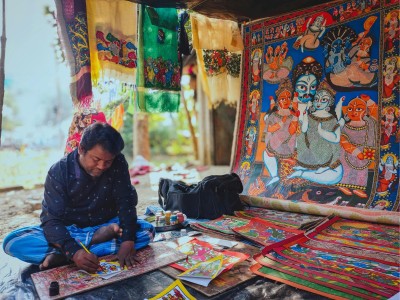The Power of Art: How Creativity Shapes Our World
-1745569773.jpg)
Art is often described as the expression of human emotion, thought, and experience. It is a medium through which we communicate our deepest desires, fears, dreams, and struggles, transcending language and cultural boundaries. From ancient cave paintings to modern digital art, creativity has been a constant force in shaping human history, influencing social movements, and driving technological innovation. The power of art extends beyond the canvas, affecting our lives in profound ways. This article delves into the transformative power of art and explores how creativity continues to shape our world today.
1. Art as a Reflection of Society
Art mirrors the society from which it originates. Throughout history, artists have used their craft to document their cultures, express their values, and respond to the events around them. The art produced during times of war, revolution, or social unrest often serves as a powerful commentary on the state of the world.
Historical Art Movements and Their Impact
- Renaissance Art: The Renaissance period, with figures like Leonardo da Vinci and Michelangelo, marked a resurgence of classical knowledge, scientific exploration, and individualism. Artists during this time sought to blend art with philosophy, religion, and science, laying the groundwork for modern Western thought.
- Impressionism: In the late 19th century, the Impressionist movement emerged as a reaction to the industrialization and urbanization of Europe. Artists like Claude Monet and Edgar Degas focused on capturing fleeting moments in time, reflecting the changes in society and the rapid transformations of the modern world.
- Modernism: As society advanced into the 20th century, modernist artists began to break traditional artistic boundaries. Movements like Surrealism, Cubism, and Abstract Expressionism challenged conventional views on reality, identity, and the very nature of art. These movements reflected the growing disillusionment with industrialization, war, and the chaos of modern life.
Art reflects not only the beauty of the world but also the struggles, conflicts, and transformations of society. Through visual representation, artists document moments in time and preserve history for future generations.
2. Art as a Catalyst for Social Change
Art has historically played a pivotal role in driving social and political change. Whether through visual art, music, theater, or literature, creative works have the power to challenge the status quo, ignite conversations, and inspire action.
Art and Activism
- Political Art: From Picasso’s Guernica, which depicts the horrors of the Spanish Civil War, to the striking imagery of the civil rights movement in the United States, art has been used as a tool to protest injustice and oppression. Artists have given a voice to the voiceless, shining a light on human rights violations, inequality, and corruption.
- Music and Protest Movements: Throughout history, music has served as a rallying cry for social and political movements. From the protest songs of the 1960s Civil Rights Movement to the rebellious punk rock of the late 20th century, music has been at the forefront of advocating for change.
- Street Art: In more recent times, graffiti and street art have become powerful forms of protest and social commentary. Artists like Banksy use public spaces to create art that critiques social, political, and economic systems, often sparking widespread dialogue.
Through activism, art challenges norms, brings attention to societal issues, and inspires individuals to act. In this way, art not only reflects the world but also shapes it.
3. The Emotional and Psychological Power of Art
Art has the power to evoke emotions and provoke thought. Whether in a museum, at a concert, or through the pages of a novel, art can make us feel joy, sadness, anger, or empathy. These emotional responses are not only a reflection of the artist's intentions but also a mirror of our shared human experience.
Therapeutic Benefits of Art
- Art Therapy: The process of creating and engaging with art has therapeutic benefits. Art therapy is used to help individuals cope with mental health issues, trauma, and stress. It provides a safe space for self-expression and helps people process complex emotions that might be difficult to articulate with words.
- Catharsis: For many, art provides a form of catharsis—an emotional release. Whether it's through painting, dancing, or playing an instrument, the act of creating or experiencing art can be deeply healing. This is why many turn to art in times of distress; it helps individuals release pent-up emotions and provides a sense of relief.
- Building Empathy: Art also fosters empathy by allowing us to see the world from another person’s perspective. A painting depicting the struggles of refugees, a novel about an immigrant’s journey, or a film about social injustice can open our eyes to the realities of others and help us understand experiences different from our own.
4. Art and Technological Innovation
As technology continues to advance, it has opened new frontiers for artistic expression. The digital age has brought about new forms of art, transforming how we create, share, and experience it.
Digital Art and the Rise of the Internet
- Graphic Design: Digital tools have revolutionized graphic design, allowing artists to create stunning visuals that were once impossible with traditional methods. From digital paintings to animated films, the possibilities for creativity are endless in the digital realm.
- Virtual Reality (VR) and Augmented Reality (AR): Virtual reality is transforming the way we experience art. Museums and galleries are now offering VR tours, allowing people to immerse themselves in the artwork. Similarly, augmented reality is enabling interactive art experiences, where users can engage with art in new and exciting ways.
- Online Platforms and Global Access: The internet has democratized art, allowing artists to share their work with a global audience. Social media platforms like Instagram and YouTube have made it easier for artists to connect with fans, showcase their work, and even sell it online. Crowdfunding platforms have allowed artists to finance their projects, bringing more creative visions to life.
Technology has not only expanded the tools available to artists but also revolutionized how we engage with art. It has made art more accessible and interactive, encouraging greater participation from audiences around the world.
5. Art as a Tool for Education
Art plays a crucial role in education, fostering creativity, critical thinking, and problem-solving skills. Whether it's through school programs, community workshops, or online courses, art education helps individuals develop important life skills.
Fostering Creativity in Education
- Critical Thinking: Creating and analyzing art requires critical thinking. Students are encouraged to interpret, question, and form opinions about the world around them. These skills are transferable to other areas of life and can help in decision-making, conflict resolution, and innovation.
- Cultural Awareness: Art also provides an opportunity to learn about different cultures, traditions, and histories. By studying art from different parts of the world, students gain a deeper understanding of global diversity and the shared experiences that unite us all.
- Creative Problem-Solving: The process of creating art often involves solving problems—deciding how to represent an idea visually, choosing the right colors, or working within constraints. These skills can enhance creative problem-solving abilities that are valuable in both personal and professional life.
6. The Enduring Power of Art
Art is more than just a form of expression; it is a powerful force that shapes our world in countless ways. It reflects our societies, challenges injustice, evokes emotions, and encourages innovation. Through art, we can understand the past, envision the future, and connect with one another in ways that transcend language and culture. In a rapidly changing world, the power of creativity remains constant, offering a universal language of expression and a tool for transformation.
As we continue to face global challenges, art will undoubtedly remain a driving force for change, healing, and growth. Whether through the brushstrokes of a painting, the lyrics of a song, or the scenes of a film, art will continue to inspire, educate, and shape the world in ways we are only beginning to understand.

Mithila Magic: The Empowering Art of Nepali Women
-1745572320.jpg)
Preserving Culture: The Importance of Protecting Traditions
-1745569776.jpg)


-1745569774.jpg)

-1745569762.jpg)
-1745569762.jpg)
-1745569769.jpg)
-1745569771.jpg)